Foreign Dispatch: Sporting Samba – Covering The Olympics in Rio
By Chris Hoenig – Sports Reporter, FOX News Radio/FOX News Headlines 24/7
The competition. The pageantry. We all see plenty of the Olympics on TV, but what is it really like being front and center, covering the Games as a journalist?
The Olympics are so much more than what you see on TV, so much more than just 306 events in 28 sports. It’s a collision of hundreds of cultures and traditions. A place where conflicts and political and religious differences are (usually) put aside, where tens of thousands of athletes, thousands of journalists and hundreds of thousands of fans come together, mingle and learn about one another, all with a mutual respect for the hard work and dedication of these elite athletes that brought us all here.
Covering the Games is exciting — exhilarating and exhausting at the same time. It’s humbling.
THE HOST CITY
Rio de Janeiro (and locally, it’s pronounced ‘dee jen-ero,’ not ‘day zhan-ehro’) is a city of immense natural beauty. Jungle-like mountains not only surround the city on three sides, they cut right through Rio in places. My daily trip from my hotel in Copacabana to the Main Press Centre (MPC) at Olympic Park took us around sheer-faced peaks and tunnels that cut right through some of these mountains.
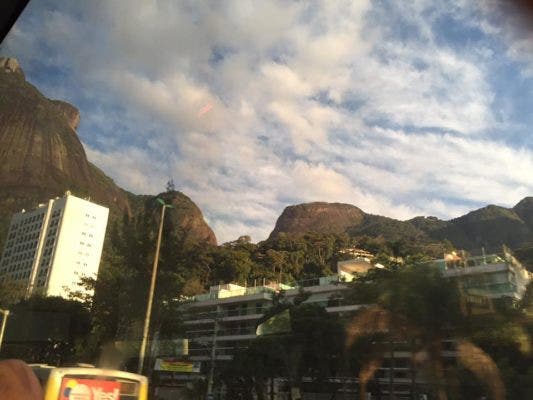
To the east, the Atlantic waters off Copacabana and Ipanema beaches are more teal than turquoise in color — they have a more green-ish tinge than the tropical blue of the Caribbean or Hawaii.
The waves roll in, creating a more pronounced curl as they break along the light sands of the beach.
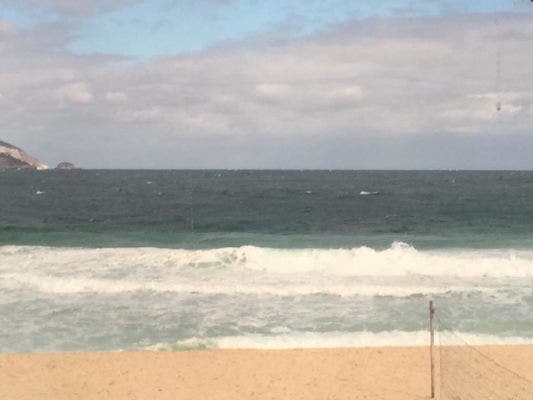
The sunrise off Sugarloaf Mountain, located at the north end of Copacabana, regularly projects pinks and oranges in streaks across the bright blue skies.
More than once, I found myself in awe of the landscape.
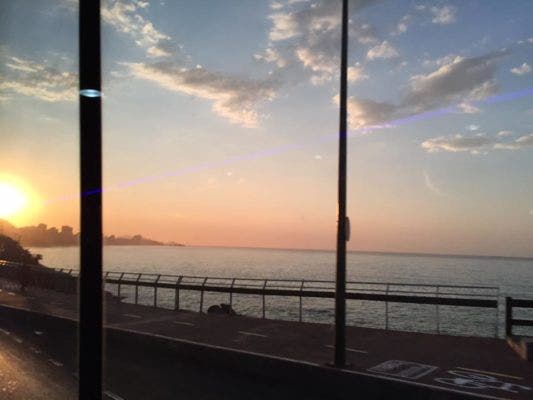
But for all the beauty, yes, Rio does have its troubles.
The population of the city has exploded over the past three decades, and the infrastructure hasn’t kept up. As a result, the city only has the capacity to treat about half of its wastewater. That means that about half of it flows, untreated, through creeks and streams, to the Guanabara Bay and the Atlantic Ocean.
One of those streams does wind its way less than 100 yards from the entrance to Olympic Park.

And it smells just as you’d think it does. As I walked back to the MPC from Serena Williams’ first-round match at Center Court, the scent wafted across the gravel walking path. And it was nauseating.
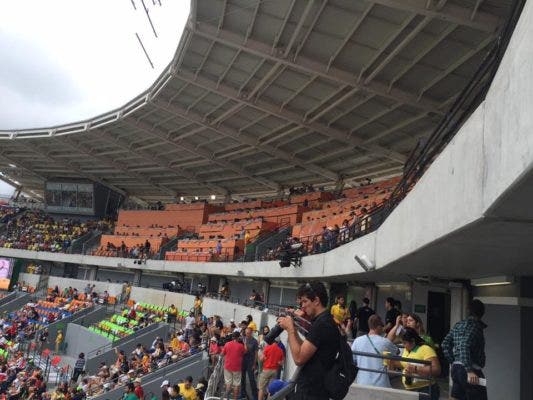
The odor hangs over much of the city. The best way I’ve heard it described is like standing next to a port-a-john on a boardwalk — the salty, ocean air mixed with sewage.
WHERE ARE WE ACTUALLY WORKING?
A typical workday started around 4:30am Eastern Time – just enough time to shower and grab some breakfast to go (more on the food in a bit) before catching a 5:00 or 5:15am media shuttle to the Main Press Centre.
The IOC organized an elaborate system of shuttles – 70-something lines in all – to get the press to/from their hotels, competition venues and the airport.
In the Copacabana zone, buses stopped at eight designated meeting points (two bus lines, each stopping at four of the meeting points). Each meeting point served roughly a half-dozen hotels — each of those hotels within roughly two-three blocks of the bus stop (my hotel was about a block and a half from the city public transit stop designated as Meeting Point #5).
Early in the morning, it was roughly an hour and 15 minutes to an hour and a half trip from Copacabana to the Main Transport Mall outside the MPC.
The MPC, from the outside, looks like a modern, 20-someodd floor building, black and white horizontal stripes integrated into the façade. Radio, print and photojournalists are based here, with private offices for those that need them.
Immediately next door, the three-story International Broadcast Centre (IBC) is home to many TV networks — whether they be studios or production offices. Just across from the entrance to Olympic Park, the upper floors of several high-rise apartment buildings shine with bright TV studio lights (those are the TV shots that look out with all the venues in the background).
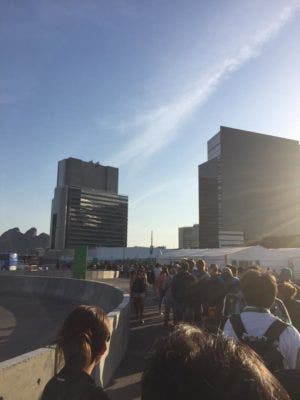
Inside, the MPC is bare bones. The ceilings are open, with all the mechanicals and plumbing on full display. The exterior walls lack drywall in many places. “Rooms” (IOC back offices, meeting rooms and bathrooms) have temporary, plywood walls – some of them reaching only halfway to the ceiling.
An inside look at the press facilities in Olympic Park… #Rio2016
A video posted by Chris Hoenig (@chris_hoenig) on
It is cold. Every six feet or so, AC vents blow at full force. Mostly everyone is wearing jackets — many proudly displaying their home country’s flag or Olympic logo.
Early in the day, you’ll find handfuls of journalists strewn about — most are working based on the time back home, so it is a 24-hour operation. By about noon, most tables are nearly full and the internet begins to slow down as the bandwith is stretched to capacity.
For me, that was the signal to move on to the next portion of my day.
Olympic Park is easy to navigate. On a nice day, you can walk from the MPC in the northwest corner to the Maria Lenk Aquatics Stadium – with its green diving pool – in the far northeast in about 20 minutes. On rainy days, there is an internal shuttle that takes press, officials and athlete’s families around the back of the park to each competition venue.
As I mentioned, I was able to pop in on some of Serena’s first-round singles tennis match. I also stopped by the gymnastics arena and the diving/water polo stadium.
They’re all connected by central walkways, right at the main fan entrance to the Park.
A video posted by Chris Hoenig (@chris_hoenig) on
From there, it was back on the bus to head back to Copacabana. Thanks to Rio’s notorious traffic jams, the mid-day trip was more like two hours (for those that went during the evening rush, it reached 2.5 hours).
My hotel became my evening base, conveniently located just two blocks from the beach and only four blocks from the Beach Volleyball Arena.
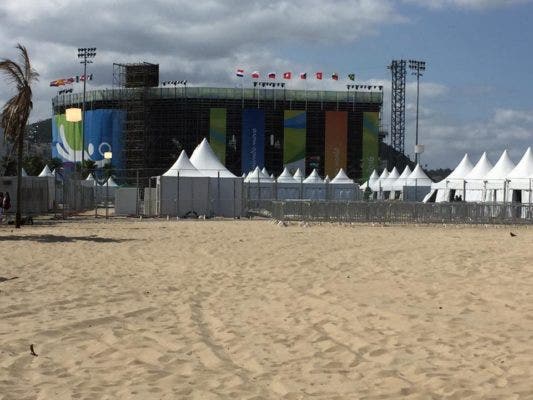
My hotel room looked nice — but the marble floors (marble and granite are cheaper in Brazil, where a large portion of the world’s supply is mined) were a disaster for radio. They created echoes that can destroy a report.
Thankfully, I was a pillow fort building pro in my youth. Trick of the trade: put your microphone inside a pillow fort and it will absorb the sound, eliminating those echoes.

By splitting my shifts, I believe my reporting picked up an added dimension. I was able to get an idea of what the atmosphere was like each day in the main tourist areas, and speak with people who were there to see the Games. The MPC is a fantastic base for reporting on scores and results, but one misses a lot of what is going on outside of that bubble.
THE LOCAL CULTURE
I have a fair amount of international travel under my belt, but Rio was unlike any city I’ve been to.
Most locals don’t speak anything other than Portuguese. A little Spanish can help because of some similarities in the languages, but communication can be a serious barrier.
A lot of speaking slow and hand signals went a long way. Ordering food involved pointing to the menu.
Oh, and when it comes to food, there were certainly local specialties… Beef:
Also, be sure to check if they offer take out BEFORE you look at the menu. Many places don’t, and those that do often charge extra for it.
When you’re a journalist looking for a quick bite to eat because you don’t want to miss a report, that’s pretty important.
Locals don’t shy away from the crowds. If they speak English, they’ll gladly share tips for places to eat, things to see and what is overpriced.
They know the issues they face. One local told me that he had never felt safer since the 85,000 troops and police officers began patrolling the city (you still should keep your head on a swivel, keep your phone put away in public and don’t flash anything valuable, because crime is still a real threat).
Bug spray and mosquito repellent were front and center at every market. But nobody talked about Zika. You cover yourself in spray and go about your business – at that point, it’s out of your control.
And the most striking impression: they’re passionate. Events starring Brazilian athletes were unlike any sporting event I’ve ever been to – and I’ve been to A LOT. They were everything you think of when you think of Brazil — colorful, festive and energetic. A giant party.
A colorful collision of sport and samba.







